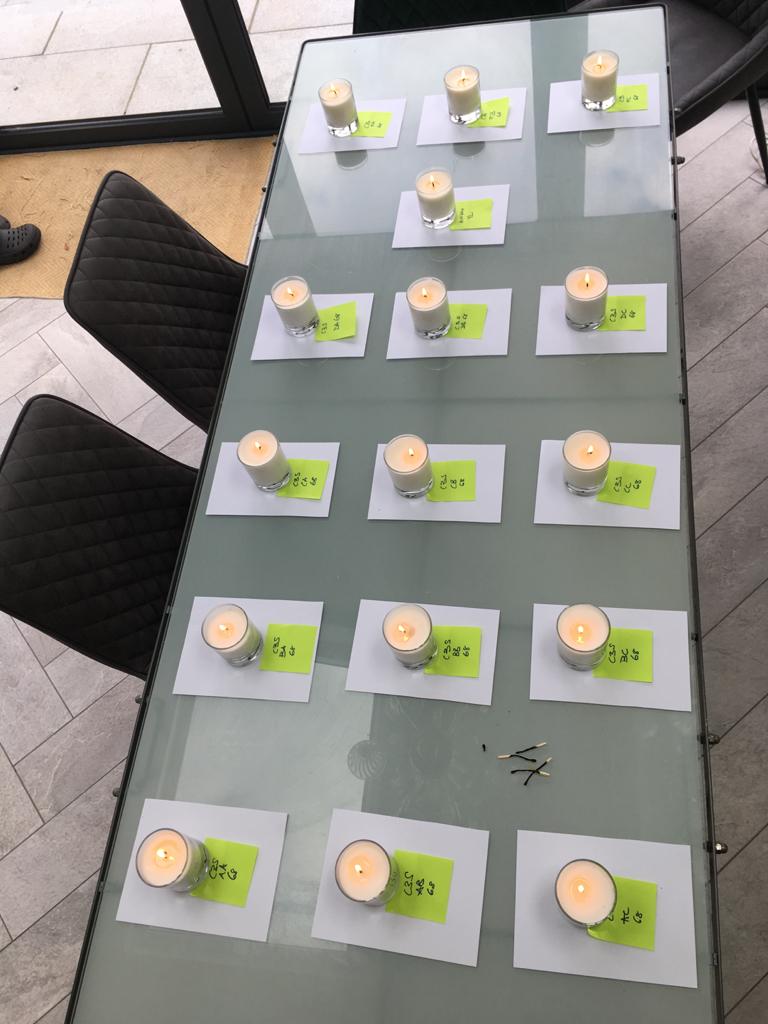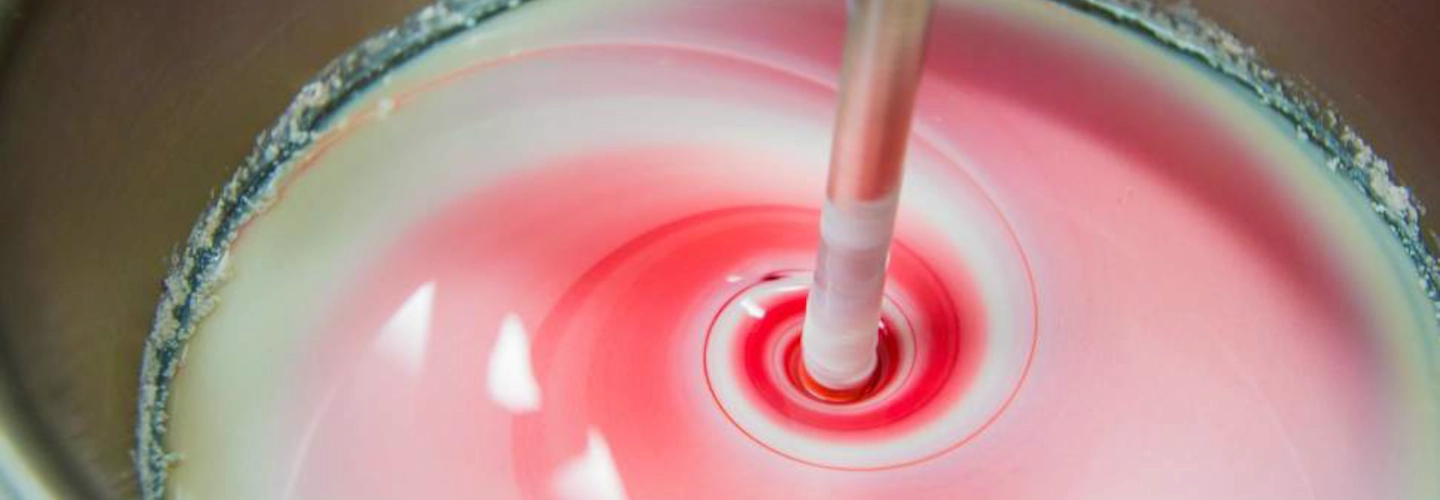Your cart is currently empty!
How to chose candle wax – the burn test

Selecting the materials to work with is a true challenge for established and starting up candle makers.
Not everyone has time and resources to establish a lab, and there are a variety of natural waxes, additives and blends out there. Just have a look at our range.
Yet, product development is a key part of a successful business that wants to leverage a unique selling point.
The number of variables to take into consideration when selecting a wax for your candles is obviously high, including the fragrances of interest, type of wick, type of mould for pillar candles or type of container for container candles, etc.
As our product development team constantly tests our own batches as well as the products we distribute, here is some testing advice based on their experience:
- Decide what variable you want to test, and maintain the rest constant.
If you test different waxes with different fragrance loads at different temperatures, you might have to many changing parameters. Whatever results you experience these might not be indicative or repeatable.
Isolate one or two comparable parameters to test, with a clear control you can refer to. - Start documenting before you start testing.
Take clear notes of the type of materials you are going to test. Once the melting, wicking and pouring starts it might be harder to keep track of what is what. After candles are cured and burned, who remembers? - More is more.
There is a significant amount of parameters to keep track of when testing waxes. Our experts note more than 40 parameters per candle. - For example
Below here is an actual example of some burn testing done by our experts. This spreadsheet has been redacted for readability as the original one included more comments and columns. Please take the results as not indicative. Yet, you will notice that the values that were being compared where wicks, candle sizes and fragrances. You might want to add observations about cold and hot fragrance throw, appearance, etc.
| Date | 11/07/2020 | 11/07/2020 | 11/07/2020 | 11/07/2020 | 11/07/2020 |
| Sample No | 5 A | 5 B | 5 C | 6A | 6B |
| Wax type | proprietary blend 1 | proprietary blend 1 | proprietary blend 1 | proprietary blend 1 | proprietary blend 1 |
| Candle Size & weight g: | 501 | 502 | 498 | 603 | 589 |
| Fragrance | velvet iris | velvet iris | velvet iris | rose | rose |
| Fragrance % | 8% | 8% | 8% | 8% | 8% |
| Wick type | CL16 | CL19 | Lux 10 / zara | CL14 | CL16 |
| Pour temp | 70 | 66 | 64 | 63 | 63 |
| Container type | glass type 1 | glass type 1 | glass type 1 | glass type 2 | glass type 2 |
| Batch code | lab sample ref | lab sample ref | lab sample ref | lab sample ref | lab sample ref |
| Room Temp 20 +/- 5 °C | 20.4 | 20.4 | 20.4 | 20.4 | 20.4 |
| Burn start time 1 | 7.30pm | 7.30pm | 7.30pm | 7.30pm | 7.30pm |
| Burn stop time 1 | 11.30pm | 11.00pm | 11.00pm | 11.00pm | 11.00pm |
| Flame stability observation: | |||||
| Five minutes after ignition | stable | stable | stable | stable | wick in wax |
| Time period 1 (60 mins) mm | stable | stable | stable | stable | had gone out, wick in wax |
| Time period 2 (120mins) | stable | stable | stable | stable | stable |
| Time period 4 (240mins) | stable | stable | stable | stable | stable |
| Prior to extinguish | |||||
| Flame height mm: | |||||
| Initial ignition | within 5 seconds | within 5 seconds | within 5 seconds | within 5 seconds. Wick curled over into wax | within 5 seconds. Wick curled over into wax |
| Time period 1 (60mins) – mm | 26 | 26 | 24 | 20 | 15 |
| Time period 1 – Carbon cap (‘mushrooming’), 60mins | clubbing | ||||
| Visible sooting | slight sooting | ||||
| Time period 2 – Carbon cap (‘mushrooming’), 210mins | 25mm | 26mm | 26mm | 21mm | 17mm |
| Sooting observation: | |||||
| Clean/blackened | some flecks | ||||
| Excessive quantity | |||||
| Performance: | |||||
| Weight after burning (g) | 477 | 478 | 479 | 380 | 578 |
| Fuel Consumption (g/h) (after 240mins) | 24 | 24 | 19 | 14 | 11 |
| Molten Wax pool | |||||
| Carbon deposits | |||||
| Tunnelling | |||||
| Excessive pooling | |||||
| Melt pool – time 1 (60 mins) glass width 80mm | 55mm / 80mm | 60mm / 80mm | 55mm / 80mm | 43mm / 65mm | 33mm / 75mm |
| Melt pool – time 1 (120 mins) glass width 80mm | 60mm | 62mm | 60mm | 53mm | 40mm |
| Extinguishing | |||||
| Aftersmoke time (seconds) | less than 3 sec | less than 3 sec | less than 3 sec | less than 3 sec | less than 3 sec |
| Glow/ember stop time | less than 3 sec | less than 3 sec | less than 3 sec | less than 3 sec | less than 3 sec |
| Container integrity (i.e. cracks) | |||||
| Self-extinguishing | |||||
| Paper burn or scorching | |||||
| Defects noted | |||||
| Before Test | some cracking around wick/sink hole. Good smooth finish on top, some pull away at bottom of glass.Good fragrance throw. | some cracking around wick/sink hole. Good smooth finish on top, some pull away at bottom of glass.Good fragrance throw. | some cracking around wick/sink hole. Good smooth finish on top, some wet spots. .Good fragrance throw. Crystallisation/motteling of wax at sides | very white appearance, cracking around wick and fine across top. Some wet spots. | very white appearance, small amount of creasing coming from wick. 1 x large wet spot. limited fragrance throw |
| During Test (60mins) | very tight burn pool – struggling | ||||
| After Test (affter 2nd burn) – 240mins | good burn – not to the edge. Solidified well, nice smooth top | burned well, almost to the edge, steady burn | |||
| reset comments | good reset | good reset | good rest | good reset/smooth, some frosting | good reset/smooth, some frosting |
| Test Results & Conclusion |
Picture by Ousa Chea – Unsplash
Recent posts

Looking to make your bottles unique and eye-catching?Our bespoke bottle sealing wax is tailored to the customer’s precise specifications, and adds a distinctive touch that enhances quality and…

We’re thrilled to announce that you can now purchase directly through our website with an online checkout!Currently, this e-commerce feature is available for a select…

Sealing wax has a rich and colorful history that dates back centuries, embodying both elegance and function. Originally used to seal important documents and signify…